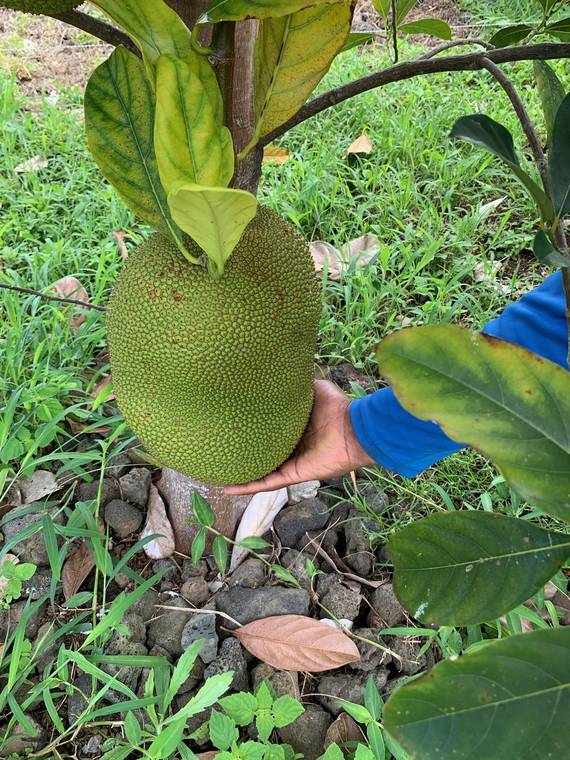
Last week we traveled vicariously to visit the tropical fruits of the New World. This week let’s imagine we are in the jungles of Borneo, home of orangutans, proboscis monkeys and humans who have lived there for tens of thousands of years.
The amazing thing about the forests of Borneo and tropical Asia is there are so many fruits and nuts good for human consumption that it would be difficult to go hungry.
ADVERTISING
When the first humans arrived in Hawaii, there were very few edible forest fruits. They brought with them the coconut palm, Mountain Apple, breadfruit, banana and kukui. Now because of human activity, we find all kinds of fruit trees growing wild, creating a new kind of Hawaiian forest complex in just a few hundred years.
To this day we continue to add to the tropical fruit tree mix by what we plant in our gardens.
If you are looking for an exotic tree just right for a small yard, grows easily, takes very little care and produces unique fruit, then get acquainted with the star fruit.
The carambola, or Averrhoa carambola, is a tropical Malaysian fruit that should be more widely grown in Hawaii. The tree was introduced to the islands about 100 years ago.
One reason we don’t see it more is that variability exists in seedling populations. Fruits of many seedlings are sour, but nurseries are beginning to carry grafted plants because of the superior fruit.
The star fruit makes a small tree and will only grow to a height of about 20 feet. The habit of growth is such that the tree can be easily trained to various shapes. If left unpruned, it develops a rounded, open crown. The tree is wind-resistant, often withstanding winds of hurricane force with little damage.
Carambola trees should be planted in a well-drained soil location since they are damaged by flooding. It will tolerate dry conditions, but growth and fruiting are reduced by extended periods of drought.
The tree does best at lower elevations. Plant the young tree in a sunny location. After it is established, look for loads of fruit.
Maintenance is easy. Fertilize with a 1-1-1 ratio fertilizer three or four times a year. Fertilizer should be spread under the canopy and extend 2-3 feet beyond.
Insect pests and diseases are usually not a problem. The root system is not aggressive, so the tree can be planted near the house, patio or driveway. The fruit produced can be eaten fresh, used in drinks or salads or made into preserves or jellies.
Those vitamin pills on your shelf, besides being pretty expensive, are not nearly as palatable and eye appealing as fresh fruit, especially when it is grown in your own backyard.
Take Vitamin A for instance. One medium size mango is supposed to contain 8,380 IU’s (International Units) while 5,000 IU’s per day are listed as adequate.
A few other dooryard fruits high in Vitamin A are Japanese persimmons, bananas, oranges, tangerines and other citrus.
Some other Asian tropical fruits famous for their contribution of vitamins are mango, mangosteen, lychee, longan, breadfruit, breadnut and jackfruit.
If you want to get the most bang for your buck, the jackfruit is a natural. It is almost pest free and will produce fruit that weigh up to 80 pounds in just a few years after planting from seed.
If you have the taste for it, the durian is becoming available at some nurseries. This rather “aromatic” fruit can be found at local farmers markets selling for $15 or more.
The jackfruit and durian are easily grown from seed. The secret is to plant the seed fresh from the fruit because they lose viability very quickly.
ADVERTISING
If you live in one of the very hot and dry parts of the island, you might consider fruit trees such as the date palm, pomegranate and fig. Originally from the Middle East, these produce the best quality fruit where conditions are similar to desert regions of North Africa and the Eastern Mediterranean. You might even try nuts such as almonds and pistachios.
For sources of these and other tropical fruits, contact local nurseries and our University of Hawaii Master Gardeners. In Kona the number is 322-4893. In Hilo call 981-5199.
"fruit" - Google News
August 22, 2020 at 05:05PM
https://ift.tt/34ozysA
Tropical Gardening: Plant tropical Asian fruit trees and experience the Old World - Hawaii Tribune-Herald (subscription)
"fruit" - Google News
https://ift.tt/2pWUrc9
https://ift.tt/3aVawBg
Bagikan Berita Ini














0 Response to "Tropical Gardening: Plant tropical Asian fruit trees and experience the Old World - Hawaii Tribune-Herald (subscription)"
Post a Comment